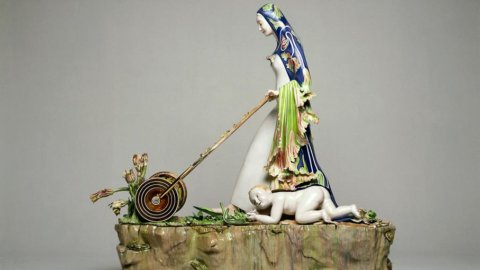From 7 June to 20 August 2014, the halls of Palazzo Te in Mantua will welcome Bertozzi & Casoni, absolute masters of polychrome ceramic sculpture. The exhibition, entitled Dove Come Quando, curated by Marco Tonelli, will present 19 typical works of the expressive language of Bertozzi & Casoni.
Palazzo Te, with its monumental rooms, its frescoes, its decorations, the internal courtyard, the perspectives of its gardens, the loggias and the fishponds overlooking the water, has been a set of visual mirages since its construction, real "lucid deceptions" as defined by illustrious art historians.
The exhibition itinerary will be characterized by the presence of two sculptures dedicated to the figure of the Madonna, an electric chair, a Cuccia Brillo, vases and clods with flowers, accumulations of bones, life-size animals, barrels, first aid drawers, bar tables , all in ceramic. For the occasion, Bertozzi & Casoni will create a sculpture that will make explicit reference to the classic Gonzaga emblems, such as the salamander, the symbolic animal. Or they will make their constellations dialogue with those represented in the Sala dei Venti of the Palazzo.
The monumental work Composition in White will be found in the Hall of Horses, a polar bear on a pack, imprisoned by the net that contains the remains of his horrid meal and the refuse of a polar expedition.
As a corollary, a didactic section will be set up in order to reveal the secrets of their work, confirming a masterful technical and inventive knowledge.
Bertozzi & Casoni is a company founded in 1980 in Imola by Giampaolo Bertozzi (Borgo Tossignano, Bologna, 1957) and Stefano Dal Monte Casoni (Lugo, Ravenna, 1961).
Their first artistic training took place at the Istituto Statale d'Arte per la Ceramica di Faenza in a climate dominated by a "cold" post-informal style then in vogue. Of greater interest to them are the figurative sculptures of Angelo Biancini, with whom Bertozzi collaborates in the study within the school, the decorative art of Gianna Boschi and the conceptual radicalism of Alfonso Leoni.
As soon as they finished their studies, Bertozzi and Casoni attended the Academy of Fine Arts in Bologna, founded a company and participated in events that attempted to focus on the protagonists and reasons for a "new ceramics".
Executive skill and detached irony already characterize their first creations in thin polychrome majolica. The collaboration (1985-1990) with the Ceramic Cooperative of Imola is important, where they work as researchers in the Experimentation and Research Center on Ceramics. In 1987 and 1988 they collaborated with "K International Ceramics Magazine" for which they also created the cover images.
In the XNUMXs executive virtuosity reached new peaks between sculptural works, intersections with design and the creation of works by established Italian and European artists.
In 1990 they created fountains and large sculptures for an urban intervention in Tama, a new district of Tokyo.
From 1993 is the large panel Say it with flowers placed on an external wall of the Civil Hospital of Imola.
In the XNUMXs a more conceptual and radical aspect emerged in their work: ceramics always took on dimensions
greater up to bordering on linguistic and realization hyperbole.
The critics and the most important national and international art galleries are interested in their work.
Their sculptures – symbolic, mocking and pervaded by a sense of attraction towards what is fleeting, transitory, perishable and in decay – have become internationally recognized icons of a not only contemporary human condition.
The corrosive irony of their works is always counterbalanced by an indestructible executive perfectionism. Between compositional surrealism and formal hyperrealism, Bertozzi and Casoni investigate the refuse of contemporary society, not excluding the cultural ones: from those of the past to those of the closest artistic trends. Icons such as the Brillo box examined by Pop Art or the cans of Artist's shit by Piero Manzoni find, in a refined ceramic version that investigates their obsolescence and degradation, both the signs of an irreparably past time and a freezing in arrangements which, conversely, entrust them to truly immortal destinies.
Since 2000, Bertozzi and Casoni have abandoned the use of majolica to favor, in a sort of epic of trash, a wider range of techniques and ceramic materials of industrial origin, varying their processes and compositions.
The physical presence of the objects and figures represented attracts for its conceptual complexity and elliptical references, the suggestion increases with the discovery of the material used and the perfect mimesis achieved and, finally, the formal implications emerge, even pictorial, of overbearingly figurative but basically conceptual and abstract.





